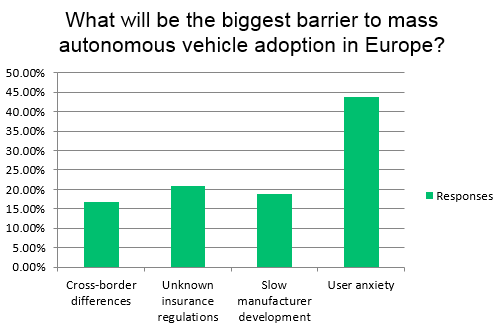Survey Results: Driver anxiety and infrastructure are the biggest barriers to mainstream autonomous market
08 June 2018

08 June 2018
Autonomous vehicles are slowly coming through development with manufacturers making claims of five years before fully driverless vehicles hit the roads. However, there are a number of different barriers to overcome before the uptake is mainstream.
In a recent Autovista Poll of Daily News Brief readers, driver unease is still the biggest obstacle for manufacturers to overcome. 44% of readers felt that this is an area that carmakers and legislators need to focus on if they want the technology to break into the mainstream. Following a series of highly publicised incidents involving autonomous vehicles from Uber and Tesla, public confidence in the technology is low.

Other barriers to technology coming through were relatively close, with unknown insurance policies in second with 21%, as insurers start to look into how to cover an autonomous car, decide who was at fault in an accident and claim from those culpable. With responsibilities split between drivers and manufacturers as well as other road users, and potentially difficult rules being required for fully driverless cars, insurance firms are slow to react, although the research into this tricky area has started.
Following this, 19% of respondents to the poll suggested that slow manufacturer development would be the biggest barrier, with carmakers having to dovetail research into the technology with electrification development, due to the need to meet strict CO2 rules and the collapse of the diesel market. Progress is being hampered by external market factors, and autonomy is less of a priority, even though it may be an answer to a changing ownership landscape. Finally, 16% of those who answered felt that differing legislations on driverless vehicles in different countries would cause cross-border issues, which would prevent people from wanting to use such vehicles.
However, of those who posted comments on the question, many said the same thing. A lot more work will be needed on infrastructure, especially in rural areas. While 5G networks will be required to ensure that cars can remain in communication with various sensors and servers, some suggested that even things such as road lines will need to be painted to ensure that technologies such as lane departure warnings are able to function properly.
The findings show that while manufacturers may be speaking boldly about their ambitions on autonomous technology, there is much more to be done, from a legislative, funding and building program to ensure that when the development is complete, users are confident to take driverless vehicles to the road.